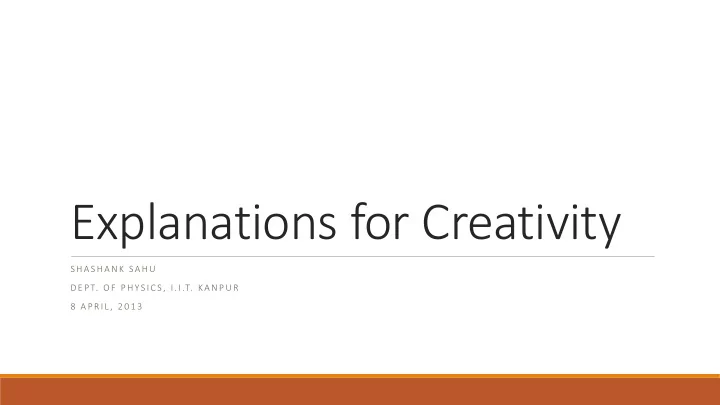

Explanations for Creativity S H A S H A N K SA H U D E PT. O F P H Y S I C S , I . I .T. K A N P U R 8 A P R I L , 2 0 1 3
• Define creativity or discovery • Model of creativity Theoretical • Campbell’s (1960) BVSR Model Background • Supporting the Hypothesis My focus • The Mittenecker Pointing Test (MPT) • The Torrance Test of Creativity (TTCT) Experiments • From MPT • From TTCT Expected result
Creativity R EQ U I R ES Novelty Utility [should be non obvious]
Campbell’s (1960) BVSR Model Blind variation and selective retention (BVSR) Model ◦ The most fundamental principle underlying Darwinian evolution ◦ Describes change in evolutionary system in general ◦ Generalization of Karl Popper’s Philosophy of Science ◦ Mechanism also explains Creativity
Blind Variation (BV) ◦ Intended BV ◦ Systematic BV : Radar Sweep ◦ BACON Rediscovers Kepler's Third Law! ◦ Stochastic BV ◦ Infinite Monkey theorem ◦ Implied BV HTTP://EN.WIKIPEDIA.ORG/WIKI/FILE:MONKEY-TYPING.JPG
Blind Variation and Selective Retention (BVSR)
RNG is correlated with elements of the creation of spontaneous actions in the brain. HYPOTHESIS
In support of this hypothesis Creativity and RNG both are ◦ sensitive to Mental disorder ◦ not significantly sensitive to mild intoxication
My Experiments THE TORRANCE TEST OF CREATIVITY (TTCT) THE MITTENECKER POINTING TEST (MPT) TTCT Figural Diagnostic tool for identification of ◦ ask-and-guess, ◦ Clinically relevant impairments of Executive ◦ product improvement, functions ◦ unusual uses, ◦ Cognitive function in healthy individuals ◦ unusual questions, ◦ just suppose TTCT Verbal ◦ picture construction, ◦ picture completion, and ◦ repeated figures of lines or circles.
My Aim IS TO LOOK FOR CORRELATION BETWEEN RNG BEHAVIOUR AND CREATIVITY INDEX
Results Figure 1. Effects of language and beer on randomness Plot of the doublets or Sequential pairs with natural number dictated. Flatness of the graph means that randomness is preserved.
Results Figure 2. Plot for Symbol Redundancy (a parameter for measuring randomness) vs. Creativity Score
Results Figure 3. Plot for MdG vs. Creativity Score
Results Figure 4. Plot for Context Redundancy vs. Creativity Score
Conclusions CQ decreases with as symbol redundancy increases. Context redundancy and Median of repetition gap distribution (MdG) does not have predictable relation with CQ.
Thank you
References Bains, W. (2008). Random number generation and creativity. Medical hypotheses G Schulter, E Mittenecker, I Papousek. (2010). A computer program for testing and analyzing random generation behavior in normal and clinical samples: The Mittenecker Pointing Test. Behavior research methods Kim, K. (2006). Can we trust creativity tests? A review of the Torrance Tests of Creative Thinking (TTCT). Creativity research journal Stanish, B. (1986). The Underlying Structures and Thoughts About Randomness and Creativity. The Journal of Creative Behavior Snyder, Allan, et al. "The creativity quotient: an objective scoring of ideational fluency." Creativity Research Journal 16.4 (2004): 415-419.
References Spatt, J., & Goldenberg, G. (1993). Components of random generation by normal subjects and patients with dysexecutive syndrome. Brain and Cognition, 23, 231± 242. Pollux, P.M.J., Wester, A., & De Haan, E.H.F. (1995). Random generation deficit in alcoholic Korsakoff patients. Neuropsychologia, 33 (1), 125± 129. Brugger, P., Monsch, A.U., Salmon, D.P., & Butters, N. (1996). Random number generation in dementia of the Alzheimer type: A test of frontal executive functions. Neuropsychologia, 34 (2), 97± 103. Preti A, Miotto P. Creativity, evolution and mental illness. J Memetics - Evol Mod Info Trans 1997;1(2) Tanaka-Yamawaki M. Human generated random numbers and a model of the human brain functions. In: IEEE conference on systems, man and cybernetics, Tokyo, Japan, IEEE, 1999.
References Simonton, Dean Keith. "Creativity as blind variation and selective retention: Is the creative process Darwinian?." Psychological Inquiry 10.4 (1999): 309-328. Kaufman, James C., and Robert J. Sternberg, eds. The Cambridge handbook of creativity. Cambridge University Press, 2010.
Extra Slides
The Mittenecker Pointing Test (MPT) Symbol redundancy Context redundancy Coefficient of constraint Frequency distribution of repetition distances Median of repetition gap distribution(MdG) Response rate Lateral preference
The Torrance Test of Creativity (TTCT) CQ ≅ Log[2, (1 + 𝑣 𝑗 )] 𝑗 𝑣 𝑗 is the number of uses offered in i th category
The Torrance Test of Creativity (TTCT) What are the maximum number of unusual uses of paper weight? You have 3 minutes. 1. Shatter the paper weight and spread it on floor, useful to track someone by his foot print 2. Put it inside fish tank to fool fish 3. As a top 4. Hit it on your bones to make them strong 5. Challenge somebody to put it in mouth (knowing that it will never come out) 6. Break it use it as a two paper weight 7. Hit on someone's head to damage his skull
The Torrance Test of Creativity (TTCT) 8. Start a competition of blowing it and getting it as far as possible 9. Check your strength of lungs by moving it by blowing 10. A very easy distraction, if it falls 11. To scare insects on your table by making sound by it 12. Paint it and decorate it as a fruit, everyone will think what this fruit is doing here 13. Paint it and ask someone is it a rock or glass 14. Smashed paper weight can be very useful to hurt bare feet thieves in room
The Torrance Test of Creativity (TTCT) 15. Smashed paper weight can be very useful to hurt by blowing it in their eyes 16. Tie it at the end of your shirt, it will be a deadly weapon 17. Use it as pendulum 18. spin it very fast, you can use it as a gyroscope (to find the direction) 19. To make beats by hitting it on table 20. Use it as a hammer to smash other objects 21. Put it on your head and meditate
Recommend
More recommend